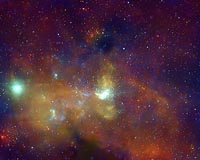| . |  |
. |
Melbourne, Australia (SPX) Feb 24, 2010 Around a quarter of the globular star clusters in our Milky Way galaxy are invaders from other galaxies, according to a team of scientists from Swinburne University of Technology in Australia. In a paper accepted for publication in Monthly Notices of the Royal Astronomical Society, Swinburne astronomer Professor Duncan Forbes has shown that many of our galaxy's globular star clusters are actually foreigners - having been born elsewhere and then migrated to our Milky Way. "It turns out that many of the stars and globular star clusters we see when we look into the night sky are not natives, but aliens from other galaxies," said Forbes. "They have made their way into our galaxy over the last few billion years." Previously astronomers had suspected that some globular star clusters, which each contain between 10,000 and several million stars were foreign to our galaxy, but it was difficult to positively identify which ones. Using Hubble Space Telescope data, Forbes, along with his Canadian colleague Professor Terry Bridges, examined globular star clusters within the Milky Way galaxy. They then compiled the largest ever high-quality database to record the age and chemical properties of each of these clusters. "Using this database we were able to identify key signatures in many of the globular star clusters that gave us tell-tale clues as to their external origin," Forbes said. "We determined that these foreign-born globular star clusters actually make up about one quarter of our Milky Way globular star cluster system. That implies tens of millions of accreted stars - those that have joined and grown our galaxy - from globular star clusters alone." The researchers' work also suggests that the Milky Way may have swallowed up more dwarf galaxies than was previously thought. "We found that many of the foreign clusters originally existed within dwarf galaxies - that is 'mini' galaxies of up to 100 million stars that sit within our larger Milky Way. "Our work shows that there are more of these accreted dwarf galaxies in our Milky Way than was thought. Astronomers had been able to confirm the existence of two accreted dwarf galaxies in our Milky Way - but our research suggests that there might be as many as six yet to be discovered. "Although the dwarf galaxies are broken-up and their stars assimilated into the Milky Way, the globular star clusters of the dwarf galaxy remain intact and survive the accretion process." "This will have to be explored further, but it is a very exciting prospect that will help us to better understand the history of our own galaxy." Image:
Share This Article With Planet Earth
Related Links Royal Astronomical Society Stellar Chemistry, The Universe And All Within It
 Peering Into The Heart Of Darkness
Peering Into The Heart Of DarknessWashington DC (SPX) Jan 06, 2010 Astronomers have long known that the supermassive black hole at the center of the Milky Way Galaxy, known as Sagittarius A* (or Sgr A* for short), is a particularly poor eater. The fuel for this black hole comes from powerful winds blown off dozens of massive young stars that are concentrated nearby. These stars are located a relatively large distance away from Sgr A*, where the gravity of the b ... read more |
|
| The content herein, unless otherwise known to be public domain, are Copyright 1995-2010 - SpaceDaily. AFP and UPI Wire Stories are copyright Agence France-Presse and United Press International. ESA Portal Reports are copyright European Space Agency. All NASA sourced material is public domain. Additional copyrights may apply in whole or part to other bona fide parties. Advertising does not imply endorsement,agreement or approval of any opinions, statements or information provided by SpaceDaily on any Web page published or hosted by SpaceDaily. Privacy Statement |